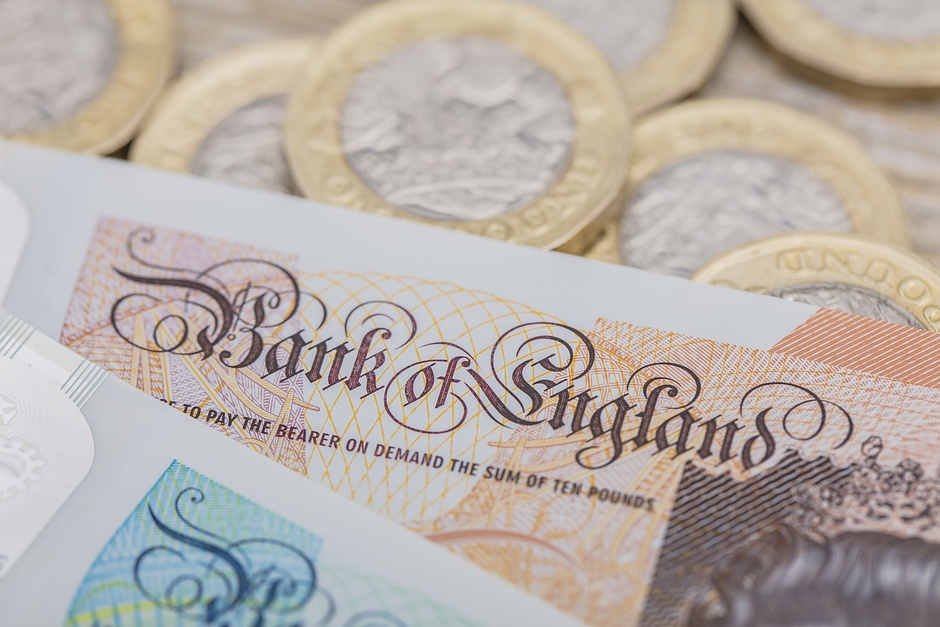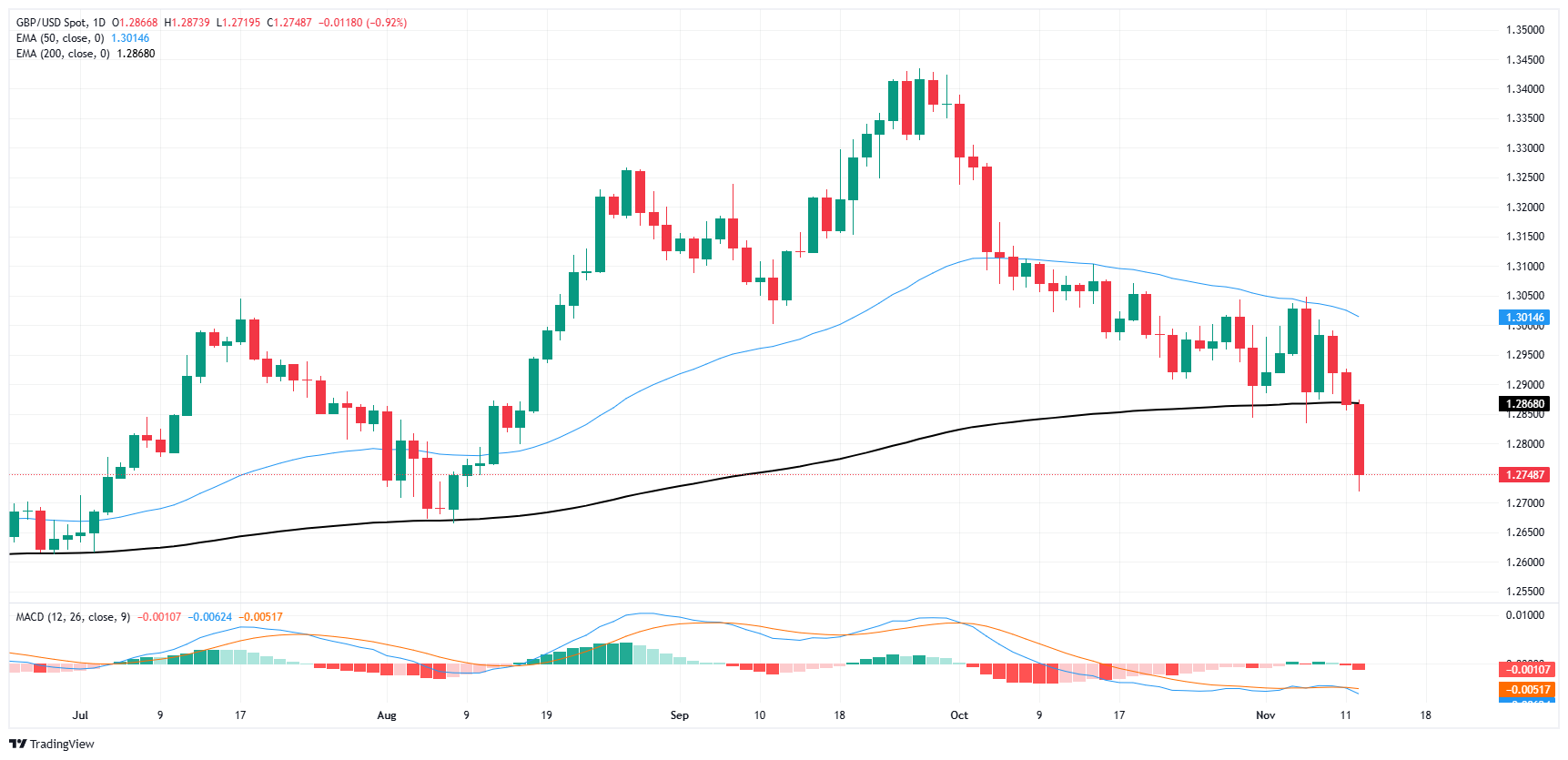Created
: 2024.11.13













![]() 2024.11.13 06:30
2024.11.13 06:30
GBP/USD lost its footing on Tuesday, shedding almost a full percent after UK labor figures came in mixed, but all Cable traders could focus on was a steeper-than-expected upswing in the UK Unemployment Rate. Outside of the UK, a broad-market bullish recovery in Greenback flows is keeping the USD well-bid, exacerbating intraday losses for Cable.
UK labor figures mostly exceeded expectations, but wages growth keeps inflation concerns elevated. While unemployment claims were below forecasts, jobless benefits seeker counts still rose compared to the previous month's revised figure.
The Bank of England's (BoE) latest Monetary Policy Report is due early Wednesday, and investors will be looking out for hints of how the BoE plans to deal with a lopsided UK economy that continues to grapple with inflation figures. On the US side, key Consumer Price Index (CPI) inflation figures will land on markets. Full-fat CPI inflation is forecast to tick higher to 2.6% YoY compared to September's print of 2.4%. Core CPI inflation is expected to hold steady at 3.3% YoY. The monthly figure for both inflation categories are broadly expected to hold flat month-on-month.
The GBP/USD daily chart shows a significant bearish move, with the pair breaking below key support levels and intensifying selling pressure. The recent price action has pushed GBP/USD under the 200-day EMA (1.2868), which previously provided solid support and has now turned into resistance. This break below the 200-day EMA is a bearish signal that suggests a shift in the long-term trend to the downside, as bears take control of the market. Additionally, the 50-day EMA (1.3014) remains well above the current price, further confirming the bearish momentum.
The MACD indicator on the daily chart aligns with the bearish outlook, as the MACD line is below the signal line, and both lines are trending lower in negative territory. The histogram is expanding to the downside, indicating that bearish momentum is accelerating. This MACD setup implies that sellers are growing increasingly confident, and buyers have yet to show any significant strength to counter the downward trend. Unless there is a substantial recovery in the MACD, GBP/USD is likely to remain pressured in the near term.
Given the recent downside break and bearish technical signals, GBP/USD may continue to face downside risk toward the next psychological support level at 1.2700. If bearish momentum persists and this level is breached, the pair could target the 1.2600 area, where further support might emerge. However, a close back above the 200-day EMA would be required to alleviate some bearish pressure and potentially signal a consolidation phase. Until then, the path of least resistance remains to the downside, favoring sellers in the short term.

The Pound Sterling (GBP) is the oldest currency in the world (886 AD) and the official currency of the United Kingdom. It is the fourth most traded unit for foreign exchange (FX) in the world, accounting for 12% of all transactions, averaging $630 billion a day, according to 2022 data. Its key trading pairs are GBP/USD, also known as 'Cable', which accounts for 11% of FX, GBP/JPY, or the 'Dragon' as it is known by traders (3%), and EUR/GBP (2%). The Pound Sterling is issued by the Bank of England (BoE).
The single most important factor influencing the value of the Pound Sterling is monetary policy decided by the Bank of England. The BoE bases its decisions on whether it has achieved its primary goal of "price stability" - a steady inflation rate of around 2%. Its primary tool for achieving this is the adjustment of interest rates. When inflation is too high, the BoE will try to rein it in by raising interest rates, making it more expensive for people and businesses to access credit. This is generally positive for GBP, as higher interest rates make the UK a more attractive place for global investors to park their money. When inflation falls too low it is a sign economic growth is slowing. In this scenario, the BoE will consider lowering interest rates to cheapen credit so businesses will borrow more to invest in growth-generating projects.
Data releases gauge the health of the economy and can impact the value of the Pound Sterling. Indicators such as GDP, Manufacturing and Services PMIs, and employment can all influence the direction of the GBP. A strong economy is good for Sterling. Not only does it attract more foreign investment but it may encourage the BoE to put up interest rates, which will directly strengthen GBP. Otherwise, if economic data is weak, the Pound Sterling is likely to fall.
Another significant data release for the Pound Sterling is the Trade Balance. This indicator measures the difference between what a country earns from its exports and what it spends on imports over a given period. If a country produces highly sought-after exports, its currency will benefit purely from the extra demand created from foreign buyers seeking to purchase these goods. Therefore, a positive net Trade Balance strengthens a currency and vice versa for a negative balance.
![]()
Created
: 2024.11.13
![]()
Last updated
: 2024.11.13

FXStreet is a forex information website, delivering market analysis and news articles 24/7.
It features a number of articles contributed by well-known analysts, in addition to the ones by its editorial team.
Founded in 2000 by Francesc Riverola, a Spanish economist, it has grown to become a world-renowned information website.
We hope you find this article useful. Any comments or suggestions will be greatly appreciated.
We are also looking for writers with extensive experience in forex and crypto to join us.
please contact us at [email protected].
Disclaimer:
All information and content provided on this website is provided for informational purposes only and is not intended to solicit any investment. Although all efforts are made in order to ensure that the information is correct, no guarantee is provided for the accuracy of any content on this website. Any decision made shall be the responsibility of the investor and Myforex does not take any responsibility whatsoever regarding the use of any information provided herein.
The content provided on this website belongs to Myforex and, where stated, the relevant licensors. All rights are reserved by Myforex and the relevant licensors, and no content of this website, whether in full or in part, shall be copied or displayed elsewhere without the explicit written permission of the relevant copyright holder. If you wish to use any part of the content provided on this website, please ensure that you contact Myforex.
Myforex uses cookies to improve the convenience and functionality of this website. This website may include cookies not only by us but also by third parties (advertisers, log analysts, etc.) for the purpose of tracking the activities of users. Cookie policy